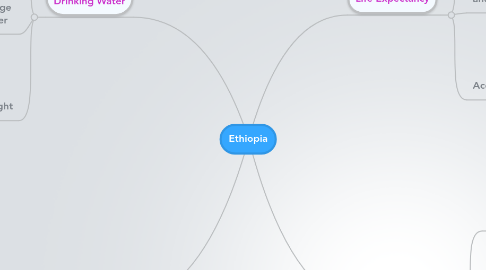
1. Life Expectancy
1.1. Food Security
1.1.1. Many people rely on their crops as their only source of food (subsistence farmers), so when the drought strikes, their crops cannot grow, and as a result they enter the hungry season. This can often lead to famine, and a large amount of people die from hunger.
1.2. Lack of Medical Resources and Health Care
1.2.1. Not many people are educated about diseases and how to prevent them. One of the biggest killers is HIV/AIDS. This is mainly because women do have any understanding about contraception.
1.3. Access to Clean Drinking Water
1.3.1. Many diseases in Ethiopia are linked to contaminated water, including diarrhea and TB. This is extremely dangerous for malnourished children as they are very vulnerable to these infections. Lack of safe water to drink also means that ,many people become ill and/or die of thirst.
2. Adult Literacy
2.1. War
2.1.1. Many adults in Ethiopia today lived through the war with Eritrea, so they didn't get the chance to attend school. Unfortunately, this meant they did not have the opportunity to learn how to read and write. Consequently adult literacy levels are very low.
2.2. Lack of resouces
2.2.1. Most schools cannot afford to provide many trained teachers. The teachers that do work are often very limited in their resources resources. Books and other equipment are expensive, and hard to come by.
2.3. Terrain
2.3.1. It is extremely hard to build school facilities in rural areas where small communities live. This is because the terrain is very rugged and not ideal to construct buildings.
3. Access to Doctors
3.1. Infrastructure
3.1.1. In Ethiopia, it is hard to build medical facilities because of the terrain they live on. Many Ethiopians live in semi-arid environments, so the land is rugged and hard to establish a strong infrastructure. In more urban areas, you will find more medical schools and hospitals.
3.2. Lack of medical training
3.2.1. Lack of educational facilities in Ethiopia means that there are fewer trained doctors and nurses to deal with the huge demand for medical help. Many poorer people are reliant on Aid agencies for medical assistance.
4. Access to Safe Drinking Water
4.1. Infrastructure
4.1.1. Most of the population live in rural areas where there is not efficient infrastructure, for example, dams, and treatment plants. This means that many people rely on water from wells dug into the ground. Or, they might have to walk great distances to source water, then carry heavy buckets on their heads, which puts immense strain on the neck and back.
4.2. Lack of knowledge about clean water
4.2.1. Because of their lack of education, they are unaware of how to purify water, and prevent water-born diseases that contaminate the water. They often become sick from drinking the water which carries diseases including dysentery, diarrhea, bilharzia, cholera, and Tuberculosis (TB)
4.3. Drought
4.3.1. Often, Ethiopians don't have access to any water at all, let alone clean drinking water. It is common for them to suffer through long periods of time without water, as the result of a drought.
